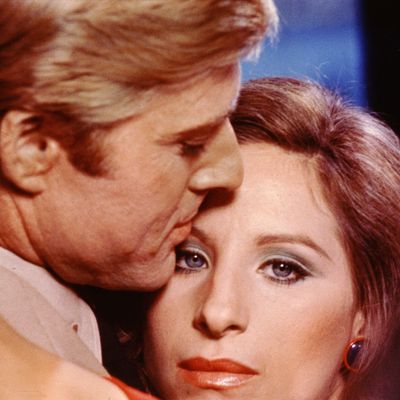
Every week for the foreseeable future, Vulture will be selecting one film to watch as part of our Friday Night Movie Club. This week’s selection comes from writer Christina Newland, who will begin her screening of The Way We Were on August 20 at 7 p.m. ET. (That is, two days after Robert Redford’s 85th birthday.) Head to Vulture’s Twitter to catch her live commentary, and look ahead to next week’s movie here.
To watch the trailer for Sydney Pollack’s 1973 weepie The Way We Were is to see how precisely the Columbia Pictures marketing team understood what it was selling: “STREISAND & REDFORD … TOGETHER,” it teases. In other words: If you want to watch two beautiful movie stars at the peak of their visual power and box office draw, you can’t do any better than this film.
Each of these actors, different though they were, had ended the last decade with an enormous, star-making hit. For her, it was the musical Funny Girl, and for him, a co-starring turn in Butch Cassidy and the Sundance Kid. Barbra Streisand and Robert Redford were subsequently among the highest-paid actors in Hollywood when they came together for this romantic drama, which set them as rosy college kids in the 1930s, a lovestruck couple in the postwar ‘40s, and disenchanted adults amid the stormy backdrop of the Red Scare in the ‘50s.
The story is of an opposites-attract romance: a WASP-y jock, Hubbell, who aspires to be a novelist, and a mousy, Jewish student radical, Katie, who refuses to bend her communist beliefs to fit in. Katie has a crush on Hubbell in college, but they belong to definite and different social stratas on campus. Years later they meet again in a Manhattan nightclub, and their romance begins in earnest. Their unlikely love affair is forever lopsided, dogged by Katie’s yearning for Hubbell, by his snippy New Englander friends, by Katie’s insistence that she is “the wrong kind of pretty” for him. They eventually move to Hollywood, where Hubbell becomes a screenwriter, only for them to be kneecapped by the incoming anti-Communist witch-hunts.
The Way We Were is told in a series of flashbacks and montages, primed for maximum nostalgia and some truly gorgeous period costuming. The entire film is Hollywood confection from start to finish, opening with the lush, familiar croon of Streisand’s famous titular song, allowing Redford to wear his navy whites for so long that he begins to look as though he’s emerged from a perfume ad. There are some scenes cut from the conclusion that make the timeline a little confusing, but The Way We Were does not endure because of its plot. It endures because of a fearsome, desirous performance from Streisand, and Redford’s cold beauty, and all the ways that it captures a one-sided desire many of us have felt.
In one scene, a drunken Redford falls into Streisand’s bed and she decides to jump in with the nervous enthusiasm of a quivering teenager. As it goes, Streisand specifically requested Redford as her leading man; he was initially reluctant to make a fluffy romance movie and unaware that it would become one of his most beloved. As for why she asked for him, well: have you seen Robert Redford in the ‘70s? All jawline and tawny hair, strapping, like he’s made of marble? He is a man so attractive that looking directly at him is like trying to look into the sun. So fairy-tale prince handsome that he caused his female co-stars forget their lines. (True story.) He and Streisand look beautiful together, with their glossy hair and pillowy lips. There’s something moving about the way she melts into him, the way his self-containment drives her to distraction, the way they look at one another with fiery appraisal. The final scene, in which Katie brushes Hubbell’s hair in a tender motion, is pure old-fashioned melodrama, and boy, is it effective.
Hubbell is not perfect: he’s largely indifferent to Katie’s politics, always suggesting she tone it down, and even while he’s knowing about his privilege (“Much like the country he lived in, everything came easy to him.” he writes of himself in the third person), he can be irritatingly smug. He’s the popular boy at school for whom so many girls pined quietly. And therein lies the film’s genius: we see him through the moon-eyed Streisand’s gaze. Her performance softens him, makes him worthwhile through her devotion. (Three years later she’d pull of a similar feat in A Star Is Born.) It’s really Streisand’s film. Her deeply identifiable heartache — her sense of feeling both “too much” and “not enough” for Redford, and for the world — is extremely affecting. And in spite of her romantic insecurity, Katie maintains the courage of her conviction, refusing to allow herself to be changed by a man; The Way We Were is surprisingly feminist in its undertones. It’s wonderful because it addresses what so many women know to be true: some men want you to be less of yourself, and that simply will not do. Even if they are Robert Redford.
The Way We Were is available to rent on Prime Video, iTunes, Vudu, YouTube, and Google Play.
More From This Series
- Helen Hunt Answers Every Question We Have About Twister
- Mr. and Mrs. Smith Is a Straight Shot of Movie Star Charisma
- The Timeless Honesty of Wild Style, the First Hip-Hop Movie

